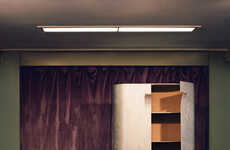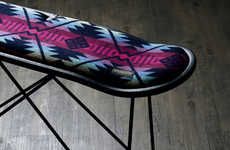
This Furniture Was Designed by Visually Impaired Students
Katherine Pendrill — November 26, 2015 — Art & Design
As part of 'The Invisible Design Project,' four visually impaired students were given the opportunity to create furniture that would appeal to those without the full use of their sight. When it comes to furniture and interior design, many people assume that the goal is to create pieces that are aesthetically pleasing. However, this project demonstrates that there is more to a piece of furniture than just how it looks.
The Invisible Design Project was initiated as a way to create furniture that would appeal to all consumers, regardless of their ability to see. To complete this task, a group of four visually impaired students were asked to create furniture based on treasured memories or tactile experiences. One of the final products is a unique stool that allows musicians to rest while preforming. Another one of the pieces is a cozy love seat designed to bring couples closer together.
By focusing on tactile elements instead of aesthetics, The Invisible Design Project brings a new perspective to traditional furniture design.
The Invisible Design Project was initiated as a way to create furniture that would appeal to all consumers, regardless of their ability to see. To complete this task, a group of four visually impaired students were asked to create furniture based on treasured memories or tactile experiences. One of the final products is a unique stool that allows musicians to rest while preforming. Another one of the pieces is a cozy love seat designed to bring couples closer together.
By focusing on tactile elements instead of aesthetics, The Invisible Design Project brings a new perspective to traditional furniture design.
Trend Themes
1. Tactile-driven Furniture - Designing furniture based on tactile elements rather than just aesthetics to create a more inclusive environment.
2. Student-led Design - Allowing students to take the lead in creating furniture that is designed to be inclusive to those visually impaired to bring new and unique ideas.
3. Personalized Furniture Design - Designing furniture based on treasured memories that are unique to each person, resulting in a more personalized experience.
Industry Implications
1. Furniture Design - The furniture industry has an opportunity to increase inclusivity by creating pieces focused more on the tactile experience.
2. Interior Design - Interior designers can consider tactile elements when selecting furniture with the goal of creating a more inclusive environment.
3. Education - Enabling visually impaired students to lead design projects, inspiring new innovations in design and accessibility.
3.1
Score
Popularity
Activity
Freshness























